В высшей степени (Russian) ("To the Greatest Heights") | |||||||
| Anthem | "Hymn of a Free Alaska" | ||||||
| Capital | New Archangel | ||||||
| Largest city | Ross | ||||||
| Other cities | New Westminster, Vladikaskady | ||||||
| Language official |
Russian (de facto) | ||||||
| others | English, Spanish, Ukrainian | ||||||
| Religion main |
Eastern Orthodox | ||||||
| others | Catholics, Jews, Protestants | ||||||
| Ethnic Groups main |
Russians and Ukrainians | ||||||
| others | English, Germans, Norwegians | ||||||
| Demonym | Alaskans (en) Аляскинцы (ru) | ||||||
| Government | Federal presidential republic | ||||||
| Legislature | General Congress | ||||||
| President | Amaliya Klobuchar (Evergreens) | ||||||
| Senate Chair | Boris Sashin (DNS) | ||||||
| Area | 3,122,934 sq vrs (3,554,093 km2 • 1,372,243 sq mi) | ||||||
| Population | 60,894,201 (2017 Census) | ||||||
| GDP Total: |
$2.140 trillion | ||||||
| per capita | $35,143 | ||||||
| Independence | from the Russian Empire | ||||||
| declared | 15 March 1917 | ||||||
| recognized | 23 January 1918 (by RSFSR) 27 November 1929 (reunification) | ||||||
| Currency | Yefimok (ефк) (AKY)
| ||||||
| Time Zones | UTC−08:00 to −10:00
| ||||||
| summer | UTC−07:00 to −09:00
| ||||||
| Date Format | dd.mm.yyyy (CE) | ||||||
| Driving Side | Right | ||||||
| Electricity | 110 V, 60 Hz | ||||||
| Plug Types | A, B | ||||||
| Calling Code | +7-2xx | ||||||
| Internet TLD | .ak, .аля | ||||||
| Organizations | |||||||
Alaska (Russian: Аляска, Alyaska), officially known as the Alaskan Democratic Federative Republic (Аляскинская Демократическая Федеративная Республика, Alyaskinskaya Demokraticheskaya Federativnaya Respublika), and commonly abbreviated as the ADFR (АДФР); is a sovereign state located along the Northwest Coast region of North America. The nation is a federation comprised of 19 governorates which are bordered by Borealia and the United States to the east, Mexico and Texas to the south, and the Russian Federation west of the Bering Strait.
The territory of modern-day Alaska was initially an integral part of the Russian Empire (with the territory being acquired from Spain and the United Kingdom). Russian America developed throughout the 19th Century as an invaluable region of the empire, due in no small feat to the numerous gold rushes within the region. By the turn of the century and the subsequent collapse of the Russian Empire, Alaska became an independent nation. Following a decade of instability and war, an American-styled liberal democracy was established. Alaska would play a key role during the Cold War as a buffer state between the two Superpowers.
Alaska is unique in that it's both the only nation in the New World to have an Eastern Orthodox majority and the only nation outside the former Soviet Union to have a Russian-speaking majority. Much like its neighbors across the Americas, Alaska is a nation of immigrants. Those of Russian, Ukrainian, English, Norwegian, German, and Chinese descent currently make up the biggest demographics within the nation.
Etymology[]
The name Alaska is derived from the Aleut idiom alaxsxaq (алахсхаӄ). The word literally translates as "the object to which the action of the sea is directed" and figuratively means "the mainland" (as opposed to the islands of the Catherine Archipelago). The word was adopted into Russian as Alyaska (Аляска). While the Aleuts (for the most part) limited the name to the peninsula of the same name, the Russian colonists gradually broadened the term to include all of their territories in North America.
The nation is formally known as the Alaskan Democratic Federative Republic, which was formally adopted in the 1930s. The name was adopted to show the young nation's commitment to democracy, federalism, and republicanism. The name was also seen as an homage to the failed democratic projects in Russian Eurasia.
Prior to the incorporation of the rival Alaskan Socialist Republic in 1942, both the formal name and the abbreviation ADFR were used for all practical purposes (such as on maps and in the news). This practice was mostly abandoned by the mid-1940s in order to promote national unity. While the Western Bloc nations would support this, the Soviet Union and other Eastern Bloc nations would continue to use the formal name well into the 1960s.
History[]
- Main articles: History of Alaska and Timeline
Russian Expansion[]
By the start of the 19th Century, the Russian-American Company (RAC) had a legal monopony on fur trading in Russian America and was the de facto administrator of the colonies. Under the leadership of Aleksandr Baranov, the RAC would solidify the North American claims of the Russian Empire and (often without the expressed support of empire) expand their economic and territorial reach on the continent. The settlement of New Archangel is established in 1804 (following the defeat of the local Tlingit clan). The most ambitious project conducted by the company began in 1812 with the founding of Fortress Ross in the Californias. Headed by Ivan Kuskov, this new colony was to become the breadbasket to supply food for the northern settlements.

Portait of Aleksandr Baranov.
Russian expansion in North America would draw the ire of the Americans and the British, both of which had pre-existing economic and territorial ambitions in the area. But it would be the Spanish who became most vocal, as the Ross colony was located well within New Spain (which was currently going through a war of independence upon the colony's founding). In 1821, the Spanish attempted to seize Fortress Ross and occupy the colony. The subsequent battle would result in a Russian victory but would result in the deaths of Ivan Kuskov and several Russian settlers. Enraged by the unprovoked attack, Tsar Alexander I would declare war on Spain, with fighting taking place in North America and in Europe (with Russian troops assisting in the restoration of King Ferdinand VII).
Following their complete victory over Spain, the Russian Empire would secure their control over the Ross colony and would emerge as the dominant player in the northwestern coast of North America. Despite continued hostilities with the Americans and the British, diplomatic efforts were made to prevent further conflict. The United States agrees to recognize Russian claims west of the Rocky Mountains in exchange for preferential trade deals. In exchange for recognizing the Colony of Columbia, the British agree to recognize Russian claims south of the Columbia River and joint control over the New Caledonia District. During the war, relations were established with the newly proclaimed Mexican Empire (with Russian assistance helping to ensure Mexico's independence from Spain). In 1826, Dmitry Zavalishin (on behalf of the Russian-American Company) would successfully purchase the Mexican territory northwest of the Sacramento River.
Following the Canadian Revolution and subsequent annexation of Upper Canada by the United States in 1840, Tsar Nicholas I would officially end Russian-American Company's administrative duties, resulting in Russian America formally being absorbed into the empire. The territory was officially divided into four new oblasts: the Kodiak Oblast (Pavlovskaya Gavan), the Oregon Oblast (Oregonsk, later renamed to Vladikaskady), the Sitka Oblast (New Archangel), and the Sonoma Oblast (Ross).
Gold Rushes[]

Fortress Ross (circa 1841).
In 1848, the discovery of gold in Northern Mexico and the Sonoma Oblast would effectively change the importance of Russian America and the region as a whole. Due to the influx of new settlers; the Russians would establish new settlements in Kuskovo, Vayrika, and Zavalishino. The once quiet Fortress Ross would soon overshadow San Fransico to become the power center of the region.
This new expansion of the Russian Empire would once again draw international attention. As part of the larger Crimean War, the British and French would attempt to secure their trading interests in the Pacific Ocean by seizing Russian ships of the Pacific Fleet. In August 1854, the Anglo-French forces would enter New Archangel and ordered the Russian forces to surrender. The subsequent seige ended in a Russian victory. Fears that Mexico and the United States would enter the war, the Anglo-French attempts to open a Pacific theater ended. Despite Russia being soundly defeated in Europe, the Crimean War highlight their commitment to their American colonies.
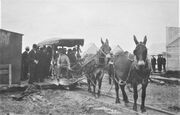
Railroad construction (circa 1910s).
Continued immigration would help push infrastructure projects in the region. Among them was the Russian-American Telegraph line in 1865, which connected North America with Europe via the Bering Sea. Despite being beaten by the Transatlantic Telegraph line in 1865, the project would continue as a means of connecting the empire. This project would also be the catalyst for the United Kingdom selling Columbia to Russia in 1867, thereby establishing the modern borders of Alaska. Additional projects undertaken were the construction of the first transcontinental railroad in the 1880s, connecting Russian America with the United States.
While the southern oblasts of Russian America were flourishing, the northern areas would remain isolated throughout the 19th Century. This changed in 1896 with several gold discoveries across northern Alaska. This would spark a new wave of immigration and the founding of new settlements — such as Belokonsk, Doroshingrad, Furugelm, and Tolstoy. While early development was done via mountain passes and steamships along the Yukon River, the southern railroads would soon expand into the north. Old settlements like Nikolayevsk and Nooshagak would see new life during this period as both railway and shipping hubs. Despite this rail expansion, some parts would only remain accessable via sled dogs.
Independence[]
By the turn of the 20th Century, Alaska had positioned itself as the "jewel of the crown" of the Russian Empire. Alaska's prominence also spurred the creation of new colonies in Eritrea and Phuket in order to shorten the distance between Saint Petersburg and its American colonies. Despite Russia's attempts to integrate its colonies into the imperial fold, Russian America would remain mostly isolated from the rest of the empire throughout its existence. It was during this time that a separate Alaskan identity began to develop and calls for greater autonomy became louder. Such calls only became stronger both during and after the Russo-Japanese War, in which Alaskans bore the brunt of the fighting against Japan.
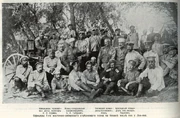
Alaskan troops in Manchuria.
Despite their victory in Korea and Manchuria, a series of rebellions broke out across the Empire. While easily quashed in Eurasia, the rebellions in Alaska continued. Fearing a larger war, those around Tsar Nicholas II pressured him to make peace. The October Manifesto was issued on October 17, 1905, granting Russian America greater autonomy within the empire. A democratically-elected territorial duma was established in New Archangel with elections taking place in March 1906. Despite this victory for Alaska, it would only prove to be short-lived and minor as the tsar was fundamentally opposed to the project. The new duma was dissolved three times in the first two years due to conflicting viewpoints. The tsar would hamper the democratic process by vetoing any laws which he personally disapproved of.
Despite the growing resentment towards Tsar Nicholas II, little was done to fight it. During World War I, Alaskans were conscripted to fight on the Eastern Front. This angered the Alaskans further as this was the first time the empire forced them to fight a war in Europe. By 1917, tensions in Alaska reached a boiling point as rebellions took place across Alaska. Combined with the bleak situation in Europe, fears of a full revolution began to appear. On March 15, 1917, the territorial duma and the governor-general unilaterally declared the independence of Alaska. Tsar Nicholas II pushed for a war to forcefully retake Alaska, but this ended in July with his abdication and the end of the Russian monarchy in Eurasia. It wouldn't be until January 1918 that Vladimir Lenin and the newly proclaimed Russian Socialist Federative Soviet Republic recognized the independence of Alaska.
Just like the civil war taking place in Eurasia, the newly proclaimed Alaskan Republic would soon become divided. Along with the Reds, Alaska would see three main factions emerge — the Blues, the Whites, and the Dougs. The Blues were native-born Alaskans who favored liberalism and republicanism. The Whites were Russian-born refugees who favored monarchism and [generally] opposed Alaskan independence. Finally, the Dougs were the English minority who opposed continued Russification. Tensions would remain low during the first years of independence, especially as Alaskans were focused on the continued situation in Russia. Once the new Union of Soviet Socialist Republics secured all of Russian Eurasia, internal tensions would return in Alaska.
Alaskan Wars[]
- Main articles: Alaskan Wars
Tensions between the Blues and the Whites came to a head in 1923 with the appointment of a new president. At the time, Alaska was still governed by the October Manifesto (though with the position of tsar and governor general being replaced with an appointed president). The pro-White Octobertists (who controlled the State Duma) favored the appointment of Grand Duke Nicholas (the nephew of the former tsar) to the presidency. Because the Grand Duke was a potential pretender to the Russian throne, the appointment was vehemently opposed by the opposition — comprised of the pro-Blue Kadets and the Esers. In protest, the opposition walked out of the State Duma, only for the Octoberists to appoint the Grand Duke without a quorum. In response, the opposition established a rival government in Vladikaskady which gained the support of the pro-Blue southern oblasts. Seeing the constitutional crisis unfolding, the Soviet Union orchestrated communist uprisings across Alaska. In the Sonoma Oblast, the local soviets strongly rejected authoritarianism and parleyed their influence into gaining autonomy from the Vladikaskady Government. In the North, the pro-Soviet leaders proclaimed the Alaskan Socialist Republic in Nooshagak. The Doug-dominated Columbia Oblast declared its independence as the Commonwealth of Columbia, with the goal of either joining the United States or rejoining the British Empire.

Alaskan troops in Yukon (circa 1925).
In the North, the ASR was able to expand its influence up the Yukon River, getting as close as 500 km from New Archangel. Due to the Alaska Range, fighting between New Archangel and Nooshagak remained confined to the Upper Yukon (with the Kenai Peninsula only seeing a few battles). Both New Archangel and Vladikaskady pushed the Commonwealth down to only the Fraser River, the Queen Charlotte Islands, and Vancouver Island. Due to the Commonwealth acting as a buffer from New Archangel, as well as controlling all of the Columbia River, the Vladikaskady Government would see calm during the 1920s. Because of this calm, the southern oblasts would see governmental changes and economic growth. By the end of the decade, Vladikaskady had effectively overtaken New Archangel as the preferred foreign partner (especially with Mexico and the United States).
Several events would take place in 1929 that would see reconciliation in Alaska. First was the death of Grand Duke Nicholas in January. While his death wasn't the beginning of reconciliation talks, it did speed things up. Second was the beginning of the Great Depression in the Fall, which showed the need to reunify in order to survive. Last, was the October Coup in the Alaskan Socialist Republic, in which General Secretary Veniamin Zhitlov was ousted in favor of Yakov Golos (a puppet of Joseph Stalin). On November 27, 1929, the governments of New Archangel and Vladikaskady would cease hostilities and reunite under a temporary charter. A few weeks later, the Commonwealth of Columbia would also make peace. A new constitution would be written and adopted in late-1930, with the President of the Vladikaskady government, Andrey Shandro, being elected the first President of the Alaskan Democratic Federative Republic the following year.

Germanovsky Raion, Ross (circa 1940).
The 1930s would still see fighting with the Alaskan Socialist Republic. By orders of General Secretary Yakov Golos, the ASR would expand its spy networks within the ADFR. This would also expand into piracy, kidnappings, money laundering, and sabotage (marking the beginning of Soviet espionage in Alaska). Despite the renewed warring period, the ADFR would still see progress as the wealth of the South could now move northwards. The ADFR would also expand its international presence for the first time during the decade. This would include asserting the old territorial claims of the Russian Empire in Antarctica. In 1935, Alaskan volunteers would participate in the Italo-Ethiopian War to defend Ethiopia and Eritrea against Fascist Italy (among those volunteers being future president Vasily Kardash).
By the start of World War II, Alaska remained neutral. This changed following Operation Barbarossa in June 1941, followed by Chinese attacks on the Soviet Union and the American-backed Philippines. Without the USSR's backing, the Alaskan Socialist Republic began to break down within a year. Seeing an opportunity, the ADFR moved it and captured Nooshagak in 1942. This marks the end of the Alaskan Wars as all of North America was now under the control of New Archangel. The administrations of Nikolay Bachinsky and Anton Glinka, Alaska would join the war on the side of the Allies. This would include the manufacturing of equipment and supplies; as well as the deployment of troops in Europe (especially in the Soviet Union and Yugoslavia) and the Pacific. By the war's conclusion, Alaska would emerge as a new economic and industrial power.
Government and Politics[]

President Amaliya Klobuchar.
The Alaskan Democratic Federative Republic is a federation and a presidential republic. The President of Alaska is elected every six-years using an electoral college (one of the few nations which still uses this process for selecting their leader), where electors are democratically elected by the citizens of the nation. The president is elected to serve a single six-year term in office, being barred from ever holding the office following their tenure. The current President of Alaska is Amaliya Klobuchar.
The General Congress is the bicameral legislature of Alaska, comprised of the Senate (upper house) and the State Duma (lower house). Each governorate is entitled to three senators each within the Senate, while deputies of the State Duma are tallied based on the population of each governorate. Both chambers are headed by a Chairman, who is elected among their peers. Boris Sashin is the current Chairman of the Senate, while Irakly Kantor is the current Chairman of the State Duma (colloquially referred to as the Spiker). Because Alaska does not have a vice presidency, the Chairman of the Senate is second in line in the event the presidency becomes vacant.
Alaskan politics are currently dominated by two political parties: the center-right Evergreens and the center-left Movement for Peace and Freedom (DMS). A third political party, the Doug minority-rights Party of Dougs and Tories, currently plays a minor role in both chambers of the General Congress (as well as local elections).
Administrative Divisions[]
- Main article: Governorates of Alaska

Governorates of Alaska.
The Alaskan Democratic Federative Republic is a federation comprised of 19 governorates (Russian: губернии, gubernii; singular: губерния, guberniya). As their name would suggest, each governorate is headed by an elected governor (губернатор, gubernator). Each governorate is autonomous and sovereign in regards to local affairs while passing national and foreign affairs to New Archangel.
Prior to independence, Alaska was an integral part of the Russian Empire and divided into six oblasts in 1917 — Kodiak, Columbia, Oregon, Sitka, Sonoma, and Yukon. With the adoption of an American-styled federation, these original oblasts were elevated and partitioned into the modern 19 governorates. The term gubernizatsiya (губернизация, "governoratization") refers to the admission of new governorates into the Alaskan Federation (similar to the term "statehood" in the United States). The most recent to achieve this was the Far North in 1994 (prior to this, the Far North was a federal territory under direct rule from New Archangel).
Alaska also possesses two dependent territories (зависимые территории, zavisimyye territorii; singular: зависимая территория, zavisimaya territoriya) — the Traversay Islands in the southern Atlantic Ocean and Ldinny Materik in Antarctica. Both of these territories are remnants of the former Russian colonial empire which are simultaneously claimed by the Russian Federation (formerly the Soviet Union). While Alaskan sovereignty over the Traversay Islands is partially recognized as being Alaskan, Ldinny Materik is barred from international recognition by the Antarctic Treaty System (in which Alaska is a signatory).
Demographics[]
Ethnography[]
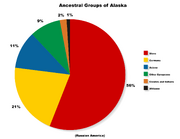
A pie chart showing largest ancestral groups of Alaska.
As with many of the nations of the Western Hemisphere, Alaska is a country of immigrants. The majority of Alaskans can trace their ancestries back to the various ethnic groups of the Russian Empire, with East Slavs being dominant. Those of Ukrainian descent currently make up the largest single group within Alaska, followed closely by those of Russian descent. Other prominent Slavic groups include: Belarusians, Bulgarians, Croats, Macedonians, Poles, and Serbs. Those of Finnish and Karelian descent currently form the largest non-Slavic group to have immigrated from the Russian Empire. Other such prominent groups include: Armenians, Estonians, Georgians, Latvians, Lithuanians, and Manchus. Due to the predominance of the Eastern Orthodox Church within Alaska, the many Orthodox immigrants to the New World often chose to settle in Alaska over other areas. These groups include: Amharas, Assyrians, Copts, Greeks, Romanians, and Tigrays.
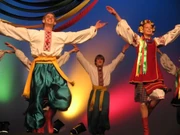
A group of Ukrainian Alaskan dancers in traditional dress.
Central Alaska (most notably within Columbia) are populated mostly by those of English and Scottish descent. Many can trace their ancestry back to the original British settlers to the region during the early 19th Century. Despite the area being sold to Russia in 1867, many of the British settlers remained in the area and developed in a distinctive group of people known as the Dougs (which currently make up a fourth of Alaska's population). It was during the latter half of the 19th Century that Danes, Norwegians, and Swedes began to immigrate to Alaska, settling mostly within New Russia (which has often been compared to Scandinavia). Germans also chose to settle across Alaska, which also included many Volga Germans. Though not as numerous, Americans and Mexicans have also settled within Alaska (mostly along the border of their respective countries).
Asians currently make up the largest non-European group within Alaska, with those of Han Chinese descent making up the largest single group. Other prominent peoples of this group include: Filipinos, Japanese, Koreans, and Vietnamese. A small number of Africans have settled in Alaska, with most tracing their ancestry back to escaped and freed slaves from the United States. Despite the mostly immigrant population, Native Alaskans currently make up roughly one-twentieth of the population (with most non-native Alaskans having some traces of native ancestry). Currently, Aleuts and Inuits make up the largest groups.
Languages[]
The Alaskan Democratic Federative Republic does not recognize any official language on the federal level. For all intense and purposes, the Russian language is the predominant national language. As of the 2017 Census, the vast majority of Alaskans were either native or fluent speakers of Russian. As a member of the Russophone, Alaska also holds a unique position as the only nation in the Western Hemisphere to use the Cyrillic alphabet. The Alaskan dialects of Russian, while mutually intelligible to speakers of Standard Russian, have been heavily influenced by other languages in the region (such as Aleut, English, and Spanish) and from immigrant groups (such as Chinese, Greek, and Ukrainian).
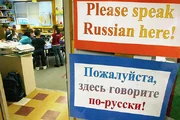
A message in both English and Russian, stating that the Russian language is the preferred means of communication at said location.
The second most-spoken language in Alaska is English, with a majority of Alaskans having some understanding of the language. Historically, English was the administrative language of the British colonies of Columbia, the Queen Charlotte Islands, and Vancouver Island; and would remain so for decades following the Columbia Sale in 1867. Early attempts to Russify the area have been mixed, yet the English language remained dominate in this area up until the 1940s. Since then, English has sharply declined as the first language of these areas (being replaced by Russian). In contrast, the overall use of English as a second language has been increasing, due especially to Alaska's relations with the United States.
Other prominent languages spoken in Alaska include: Armenian, Chinese, Finnish, German, Greek, Hindustani, Japanese, Korean, Manchu, Norwegian, Polish, Punjabi, Spanish, Swedish, Tagalog, Ukrainian, Vietnamese, Yiddish, and Yugoslav (to name a few). Among the Alaskan Indians, Aleut remains the most-spoken. Haida, Inuit, Pomo, Tlingit, and Yupik are also spoken by their respective communities.
Religion[]
Alaska is constitutionally a secular state. This includes articles which defines the separation of church and state, as well as guaranteeing the religious freedom for all citizens.
From a cultural and demographic viewpoint, Alaska is a Christian-majority state. Unlike their continental neighbors, Alaska is unique for being the only nation in the New World to be dominated by Eastern Christians. This began in the late 18th Century as the Russian Empire spread Christianity, by means of the Russian Orthodox Church, to the native populations of the Pacific Northwest. Later immigrants to Alaska would hailed from the Russian Empire, as well as other territories of Eastern Christian origin (such as Armenia and Greece).

Those adhering to the Eastern Orthodox Church makeup the majority of Alaska's population, with the Orthodox Church in Alaska (OCA) having jurisdiction over all of Alaska and the New World. The OCA gained full communion in the 1970s, which occurred decades after Alaska's independence from Russia and formal separation from the Russian Orthodox Church following the Russian Revolution. Following their separation from the ROC, Alaskan Eastern Orthodoxy began to incorporate elements of non-Russian churches (such as Bulgarian, Georgian, Greek, Macedonian, Romanian, Serbian, and Ukrainian). Coexisting with the OCA is the semi-autonomous Russian Orthodox Church Abroad, as well as several factions of Old Believers and Spiritual Christians (such as the Doukhobors and the Molokans).
Adherents of the Oriental Orthodox Church also have a strong presents across Alaska. Unlike the already established Eastern Orthodox Church, Oriental Orthodoxy was first introduced to Alaska by Armenian settlers during the late 19th Century, as well as Copts and Ethiopians throughout the 20th Century. Off the churches in communion operating in Alaska, the Armenian Apostolic Church is currently the largest by adherence.
Outside the norms of Eastern Christianity, Anglicans and Protestants collectively make up the largest population of Alaska's Western Christians. Both practices were introduced by American, British, and Scandinavian explorers and colonists throughout the 19th Century. In order of active followers, the largest Protestant groups include: Pentecostals, Lutherans, Baptists, Adventists, Methodists, Presbyterians, as well as a sizable minority of Russian Mennonites. While the Catholic Church possesses a strong following across the country, the vast majority of Alaskan Catholics tend to worship in Eastern-Rite (Greek Catholic) churches. The last major group of Christians include those of the Church of Jesus Christ of Latter-day Saints (Mormons).

Roughly comprising of 12% of the population, Judaism is the second-largest religion practiced in Alaska. Judaism was introduced to Alaska throughout the 19th Century by Jewish settlers from the Russian Empire (especially the Pale of Settlement), with most settling in Alaska to escape the Pogroms and the Holocaust. Among those who belong to a synagogue, most adhered to the teachings of Reform Judaism. Other Jewish groups include Conservatives, Orthodox, and Reconstructionists.
Buddhists (at about 10% of the population) comprise the third-largest religious group in Alaska. Buddhism was first introduced by Kalmyk settlers during the early 19th Century, with later immigration from East Asia only helping its expansion. Later cooperation with European colonists and Alaskan Indians would culminate in the formation of New World Buddhism, which has emerged as the most-practiced school among Alaskans. Along with NWB, the schools of Mahayana and Vajrayana are also practiced within the country, as well as a small population of Theravada Buddhists.
Other prominent religious groups in Alaska include (in order of prevalence): Hindus, Muslims, Taoists, Shintoists, Neo-Pegans, Sikhs, Scientologists, Bahá'ís, and Zoroastrians (among others). Approximately 15% of Alaskans describe themselves as being either spiritual but not religious, irreligious, agnostic, and/or atheist.
| |||||||||||||||||||||||




